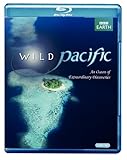
Average Reviews:

(More customer reviews)For the hi-def nature lover, this is another gem from the BBC, but not an unblemished gem. It has its fair share of problems both structurally and technically. Here you'll get 6 episodes divided onto two 50 GB discs, with a total runtime of 353 minutes. That's nearly 6 hours of footage, so you'll definitely get your fill of naturey goodness. It's 1080i here, not 1080p. From 6 feet away, it's not a problem, but randomly sampling a scene from 3 feet away, I did notice noise in darker areas and judder in fast-moving scenes like pans of palm leaves and waves.
To sum up the series, it shows some of the very amazing and unusual birds, insects, fish, and mammals of some of the 20,000 islands dotting the Pacific. But it also shows a heck of a lot of people. Despite the title being "Wild Pacific", humans are in every episode. I found out when I popped in the disc that the original (and more accurate) UK title is "South Pacific", and I was definitely misled by the name change for the US market. With every episode, the story keeps going back to one of the traditional societies of the islands, lost colonists/sailors, or modern people.
There's still a lot of informative and entertaining footage, including rare glimpses of animals, impossibly close shots, and more of that signature stunning photography that we've come to expect from the BBC. I particularly liked the cloud fly-throughs and beautiful aerial shots of atolls, pristine aquamarine lagoons, and islands that are scattered throughout the segments (on "Ocean of Volcanoes"). There's also some lush underwater photography (corals, lava, and fish). These I enjoyed the most. But it's not all animal eye candy and idyllic seas, tranquil islands, and forests. A strong, somber, and perhaps heavy-handed theme of seriousness runs through half of the episodes. "Strange Islands", "Fragile Paradise" for example (both on Disc 2), deal with the effects of humans on the seas and land, including environmental destruction, wild-life decimation by human-introduced species like goats and cats, extinction, shark-finning, and over-fishing.
What I found to be most problematic however, is the narrative flow of the individual episodes. It jumps around all over the place, from land to sea to bug to bird to fish to another island to people, sometimes even within the space of 10 minutes. This kind of editing is disorienting, aimless, and meandering, like a ship adrift at sea, an image that the series keeps returning to. Instead of one full episode on focused on say, "Birds", one on "Fish", one on "Lizards and Insects", and one on "People", its divided into a confusing set of titles and aimless segments called simply "Oceans of Islands", "Castaways", and "Endless Blue" (Disc 1) and the episodes listed above. "Wild Pacific" sacrifice quality and depth for quantity. It doesn't stay focused on many of the more exotic animals for very long and some of the shots are only cursory and superficial, lasting a mere second or two. For example, I wanted to know more about the caterpillar with the scorpion tail, the smiley face spider, or the bizarre translucent creatures of the deep ocean (entire segment is only 1.5 minutes). The animals that you've seen plenty of times in other nature shows, you'll see them a lot here too (albatrosses, sharks, dolphins, whales, sea turtles). Meanwhile, the yellow sea slug and pygmy seahorse aren't even named as the shots cut away.
Another complaint is the narration itself. Being used to hearing Sir David Attenborough's warm and affable voice on so many BBC documentaries (like the superb Planet Earth Series [Blu-ray], The BBC Natural History Collection featuring Planet Earth (Planet Earth/ The Blue Planet: Seas of Life Special Edition/ Life of Mammals/ Life of Birds), and Nature's Most Amazing Events, I found Benedict Cumberbatch dry, disengaging, and mostly monotonous. He has a baritone timbre similar to George Page of Nature fame but none of the charm as a storyteller. Whereas you can hear the genuine love, liveliness, and enthusiasm in Attenborough's voice, Cumberbatch sounds like he is reading directly from the script. His cadence and pitch rarely changes.
Lastly is the BAD menu design. The white text turns to yellow when selected, making it very hard to see. None of the chapters are labeled with any description. The only subtitle is English, and finally, the six 10-minute making-of segments sandwiched between the episodes are only mildly interesting. I recognized one segment taken in whole from Galapagos [Blu-ray], only with new narration added.
I give this a reluctant 4 for its problems. Still worth watching and owning if you like documentaries, but be aware of the issues I've outline.
Click Here to see more reviews about: Wild Pacific (2009)
This landmark series explores the sheer scale and majesty of the largest ocean on Earth, the isolation of its islands, the extraordinary journeys wildlife and humans have gone through to reach these specks of land, and what happened to both after their arrival. Unimaginably vast, the Pacific is 99% water and only 1% land - you could fit the whole of the world's landmasses into it and still have enough room for another Africa! The distance between these islands can be huge - literally hundreds or thousands of miles - but somehow, life made it there. Isolation does curious things - animals evolve and adapt in strange ways. Witness flesh-eating caterpillars, giant crabs capable of opening coconuts, geckos that can breed without any need of a male, frogs that have never been tadpoles... Beyond cliched images of swaying palms and idyllic beaches, this is the real, immense and surprising South Pacific.

No comments:
Post a Comment